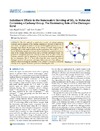Identificador persistente para citar o vincular este elemento:
https://accedacris.ulpgc.es/jspui/handle/10553/75109
| Título: | Substituent effects in the noncovalent bonding of SO2 to molecules containing a carbonyl group. The dominating role of the chalcogen bond | Autores/as: | Azofra Mesa, Luis Miguel Scheiner, Steve |
Clasificación UNESCO: | 2307 Química física | Fecha de publicación: | 2014 | Publicación seriada: | Journal of Physical Chemistry A | Resumen: | The SO2 molecule is paired with a number of carbonyl-containing molecules, and the properties of the resulting complexes are calculated by high-level ab initio theory. The global minimum of each pair is held together primarily by a S···O chalcogen bond wherein the lone pairs of the carbonyl O transfer charge to the π* antibonding SO orbital, supplemented by smaller contributions from weak CH···O H-bonds. The binding energies vary between 4.2 and 8.6 kcal/mol, competitive with even some of the stronger noncovalent forces such as H-bonds and halogen bonds. The geometrical arrangement places the carbonyl O atom above the plane of the SO2 molecule, consistent with the disposition of the molecular electrostatic potentials of the two monomers. This S···O bond differs from the more commonly observed chalcogen bond in both geometry and origin. Substituents exert their influence via inductive effects that change the availability of the carbonyl O lone pairs as well as the intensity of the negative electrostatic potential surrounding this atom. | URI: | https://accedacris.ulpgc.es/handle/10553/75109 | ISSN: | 1089-5639 | DOI: | 10.1021/jp501932g | Fuente: | Journal of Physical Chemistry A [ISSN 1089-5639], v. 118, p. 3835−3845 |
| Colección: | Artículos |
Citas de WEB OF SCIENCETM
Citations
53
actualizado el 08-jun-2025
Visitas
101
actualizado el 31-may-2025
Descargas
228
actualizado el 31-may-2025
Google ScholarTM
Verifica
Altmetric
Comparte
Exporta metadatos
Los elementos en ULPGC accedaCRIS están protegidos por derechos de autor con todos los derechos reservados, a menos que se indique lo contrario.
